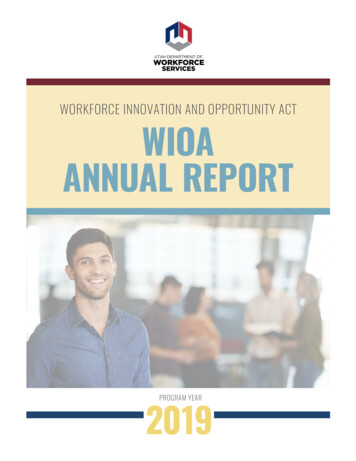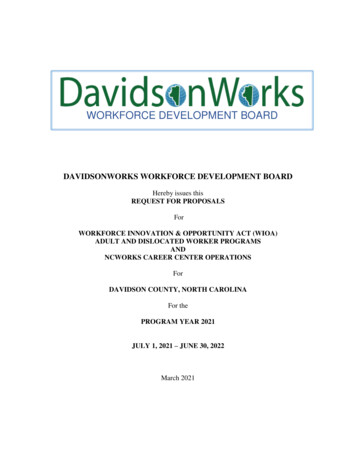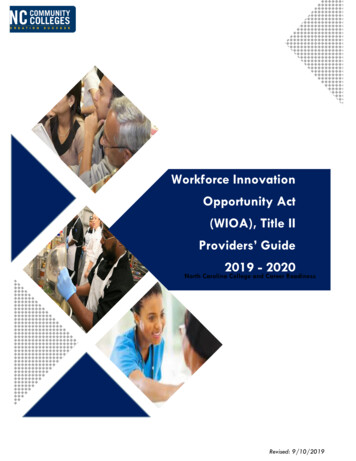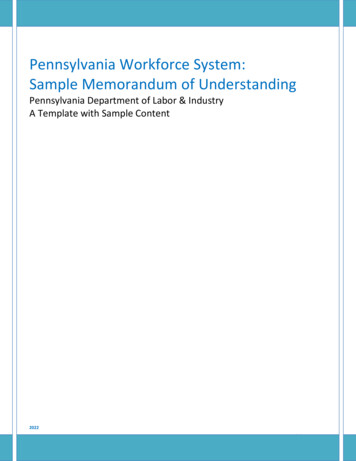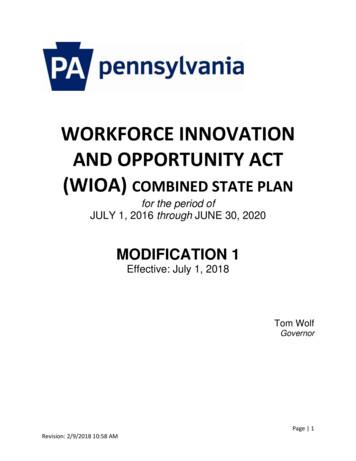
Transcription
WORKFORCE INNOVATIONAND OPPORTUNITY ACT(WIOA) COMBINED STATE PLANfor the period ofJULY 1, 2016 through JUNE 30, 2020MODIFICATION 1Effective: July 1, 2018Tom WolfGovernorPage 1Revision: 2/9/2018 10:58 AM
Table of ContentsSection I – Strategic Planning Elements .7Governor Wolf’s Strategic Vision for Workforce Development in the Commonwealth of Pennsylvania 7Goal 1: Establish Career Pathways . 8Goal 2: Invest in Talent and Skills for Targeted Industries in Strategic Partnership with Employersand Educational Institutions . 10Goal 3: Increase Work-Based Learning Opportunities for Youth . 12Goal 4: Engage Employers to Strengthen the Connection of Education and Training and theEconomy, Increase Investment in Critical Skills and Increase Jobs that Pay . 14Goal 5: Strengthen Data Sharing and More Effectively Use Data. 16Economic Analysis . 17Workforce Development System – Analysis . 25Workforce Development System – Alignment Strategy . 29Desired Outcomes. 31Section II – Operational Planning Elements . 34State Board Functions . 34Core Program Alignment . 35Alignment with Other Partner Programs . 39Coordination, Alignment and Provision of Services to Individuals . 46Coordination, Alignment and Provision of Services to Employers . 47Engagement with Educational Institutions . 49Partner Engagement with Other Education and Training Providers . 51Leveraging Resources to Increase Educational Access . 52Improving Access to Postsecondary Credentials . 54Coordinating with Economic Development Strategies . 55Section III – State Operating Systems and Policies . 56State Program and State Board . 58Assessment of Programs and One-Stop Partners . 59Distribution of Funds for Core Programs . 62Program Data . 68Priority of Service for Veterans . 70Page 2Revision: 2/9/2018 10:58 AM
Priority of Service for Recipients of Public Assistance, Other Low-income Individuals, and Individualswho are Basic Skills Deficient . 71Non-Discrimination and Accessibility . 76Section IV – Program Specific Requirements . 79Local Area Designation. 79Local and Regional Planning . 80State Policies and Guidance . 81Governor’s Set-Aside Funding . 82Rapid Response Services . 82Trade Adjustment Assistance . 87Eligible Training Provider List (ETPL) and Training Models . 90Youth Activities . 93Wagner-Peyser Act Program. 99Agricultural Outreach Plan . 102Title II Programs . 112Local Activities. 112Corrections Education and other Education of Institutionalized Individuals . 114Integrated English Literacy and Civics Education Program . 115State Leadership . 117Assessing Quality. 119Vocational Rehabilitation Programs . 120Input of State Rehabilitation Council . 120Request for Waiver of Statewideness . 126Cooperative Agreements with Agencies Not Carrying Out Activities Under the Statewide WorkforceDevelopment System . 128Coordination with Education Officials . 130Cooperative Agreements with Private Nonprofit Organizations . 132Coordination with Employers . 133Interagency Cooperation . 135Comprehensive System of Personnel Development; Data System on Personnel and PersonnelDevelopment. 136Statewide Assessment . 144Annual Estimates . 170Page 3Revision: 2/9/2018 10:58 AM
State Goals and Priorities . 172Order of Selection . 173Goals and Plans for Distribution of title VI Funds . 175State's Strategies. 176Quality, Scope, and Extent of Supported Employment Services . 180Career and Technical Education Programs Authorized under the Carl D. Perkins Career and TechnicalEducation Act of 2006 . 183Planning, Coordination and Collaboration Prior to State Plan Submission . 183Program Administration. 186Provision of Services for Special Populations . 208Accountability and Evaluation . 210Tech Prep Programs . 219Financial Requirements. 223Temporary Assistance for Needy Families Program (TANF) . 226Safeguarding Information . 237Reductions of Out-of-Wedlock Births . 238Education and Training to Reduce Statutory Rape . 240Delivery of Benefits . 243Access to Benefits . 244Families Entering Pennsylvania from Another State . 245Treatment of Noncitizens . 245Determining Eligibility . 245Work and Self-Sufficiency . 246TANF State Plan. 246Trade Adjustment Assistance . 277Coordination with Other Programs. 278Use of Funding . 278Benefit and Service Approvals by Merit Staff . 278Jobs for Veterans State Grant . 278Senior Community Service Employment Program (SCSEP) Plan. 282Background . 282Economic Projections and Impact. 283Page 4Revision: 2/9/2018 10:58 AM
Service Delivery and Coordination . 284Location and Population Served, including Equitable Distribution . 289SCSEP Operations . 292Community Services Block Grant . 297Reintegration of Ex-Offenders (REO) Program . 299Coordination of Services and Activities for Justice-Involved Individuals . 299Innovative Employment and Training Programs. 300Section V – Assurances . 302Common Assurances. 302Title I-B Assurances . 307Wagner-Peyser Assurances. 309Adult Basic Education and Literacy Programs Certifications and Assurances . 309Vocational Rehabilitation Certifications and Assurances . 311EDGAR Certifications and Other Assurances for the Perkins Career and Technical Educational and TechPrep Programs. 315TANF Certifications . 318Trade Adjustment Assistance Assurance . 319SCSEP Assurance . 320Section VI – Appendices . 321Appendix I – Pennsylvania Workforce Development System . 321Appendix II – Labor & Industry Workforce Programs Organizational Chart. 322Appendix III – Adult Basic Education Organizational Chart . 323Appendix IV – Local Workforce Development Areas . 324Appendix V – Designated Planning Regions. 325Appendix VI – Jobs for Veterans State Grant Hire and Mandatory Training Completion Dates . 326Appendix VII – Statewide Employment Projections for the Top 25 Industries with the HighestPercentage of Workers Aged 55-plus . 328Appendix VIII – Statewide Employment Projections for the Top-Employing Occupations in theIndustries with the Highest Percentage of Workers 55-plus . 329Appendix IX – On-The-Job Training (OJT). 331Appendix X – Educational Attainment Abbreviations. 333Appendix XI – Ratio of Income to Poverty for the Population 55 and over, Pennsylvania Counties:2011-2015 . 334Page 5Revision: 2/9/2018 10:58 AM
Appendix XII – Designing the Future: A Workforce Innovation and Opportunity Act WorkgroupMeeting Schedule . 336Appendix XIII – Sector Strategies and Workforce Intermediaries . 341Page 6Revision: 2/9/2018 10:58 AM
Section I – Strategic Planning ElementsGovernor Wolf’s Strategic Vision for Workforce Development in theCommonwealth of PennsylvaniaDescription of state's strategic vision and goals for preparing an educated and skilled workforce(including preparing youth and individuals with barriers to employment) and for meeting the skilledworkforce needs of employers, including goals relating to performance accountability measures basedon primary indicators of performance described in Section 116(b)(2)(A), in order to support economicgrowth and economic self-sufficiency, and of how the state will assess the overall effectiveness of theworkforce investment system.Describe the strategies the state will implement, including sector strategies and career pathways.On July 22, 2014, President Obama signed the Workforce Innovation and Opportunity Act (WIOA)providing a framework for governors and states to make changes to their workforce systems. The federallaw sets the parameters for the workforce system which is an integral part of the commonwealth’s abilityto serve job seekers and employers. WIOA will enable the commonwealth to align workforce prioritiesacross multiple training providers, employers, and other partners to ensure we are creating a skilledworkforce for today and the future.An effective workforce development system is built on a foundation of alignment, innovation, employerengagement, accountability, and improved data. Pennsylvania will look beyond WIOA to set broad goalsfor a comprehensive workforce development system that increases the number of “jobs that pay,”expands the number of “schools that teach” the skills necessary to succeed in college and careers, and isa model of “government that works.” We will do this by designing and implementing a workforcedevelopment system that addresses three core challenges facing the workforce system:1. The workforce system, and education and training providers are not well aligned with the needsof employers who provide jobs that pay.2. Too many workforce programs operate in their own individual silos rather than being integratedinto an overall system that leverages multiple funds to better serve employers, job seekers, andincumbent workers.3. The workforce system lacks a support structure of training programs and employer peer-learningopportunities, including Registered Apprenticeship programs and Sector Partnerships, whichenables and encourages more employers to invest in their workers and implement bestorganizational practices that create more jobs that pay.Pennsylvania will provide the highest quality of service to job seekers, incumbent workers, and employersby addressing these challenges through well-coordinated approaches at the state and local levels. Systemaccess will be enhanced using technology and creative partnerships with community organizations andother service providers. While access will be improved for all job seekers and incumbent workers, theprovision of services and training will be focused on those most in need and hardest to serve.Our five broad goals for the commonwealth’s workforce development system are:Page 7Revision: 2/9/2018 10:58 AM
1. Establish career pathways as the primary model for skill, credential, and degree attainment andprovide all Pennsylvanians, with an emphasis on Pennsylvanians with barriers to employment, anopportunity to obtain a job that pays.2. Expand public-private investment in the state’s pipeline of workers and in incumbent workers fortargeted industry sectors from entry-level skills to middle skills through Next Generation SectorPartnerships, the Workforce and Economic Development Network of Pennsylvania (WEDnet PA),and other innovative strategies.3. Increase opportunities for all youth to participate in work-based learning through summeremployment, pre-apprenticeship, apprenticeship, internships, and other experiences in theworkplace.4. Engage employers through multi-employer workforce partnerships to improve the connectionand responsiveness of workforce programs to the demand side of the labor market, increasepublic-private investment in critical skills, and support the spread of employer practices thatcreate jobs that pay.5. Strengthen data sharing across state agencies and workforce development partners to betterunderstand education and employment outcomes, and rely more effectively on data to improveand target our efforts.A key factor in accomplishing our five broad goals will be to boost interagency cooperation on workforceissues to achieve a team effort to implement this WIOA plan and to amend it as necessary. Thedevelopment of this WIOA State Plan is the starting point for an unprecedented effort in Pennsylvania totranscend the fragmentation of workforce programs. Overcoming silos and promoting programintegration are easy goals to talk about but very difficult to achieve. In Pennsylvania today, however, thecommitment to achieving these goals–from getting all workforce agencies and programs pulling towardunified goals and better outcomes for job seekers, incumbent workers, employers, and allPennsylvanians–starts at the very top, with Governor Wolf. State agencies will work together to leverageresources, both federal and other, to achieve Governor Wolf’s Strategic Vision.Goal 1: Establish Career PathwaysIt is imperative that the workforce development system provide training for skills that lead to employmentin High Priority Occupations (HPOs) or entry-level occupations that lead along a career pathway into HPOs.As defined in WIOA Section 3(7), career pathways must be diverse with multiple entry and exit pointsallowing individuals of varying abilities, including low-skilled adults and youth with multiple barriers toemployment, to have realistic access to pathways. The commonwealth will look to support careerpathways that help adults and youth advance among multiple occupations, advance within an occupation,or move to a new occupation that has similar skills to a previous occupation. The strategies outlined belowwill support the establishment and promotion of career pathways, with an emphasis on providing accessto those with substantial barriers to employment.Additional strategies and initiatives to support career pathways include:1.1 Local Workforce Development Boards (LWDBs), in partnership with employers, multi-employerworkforce partnerships, and secondary and postsecondary education providers, will develop careerpathway programs meeting the requirements of WIOA. Career pathway programs will include AdultBasic Education (literacy and numeracy, English-as-Second Language, and high school equivalencyinstruction) and will permit participants to enter at any of these levels in addition to entering at thepostsecondary level.Page 8Revision: 2/9/2018 10:58 AM
1.2 The commonwealth will create a comprehensive career pathway system that combines education,training, counseling, and support services from multiple programs, including secondary andpostsecondary career and technical education, adult and literacy education, Temporary Assistance forNeedy Families (TANF), Supplemental Nutrition Assistance Program (SNAP) Employment and Training,and higher education financial assistance, in addition to core programs of WIOA.1.3 The commonwealth will mainstream job seekers with barriers to employment to the maximum extentpossible by offering realistic entry points into career pathways and by ensuring necessary supportiveservices are in place and coordinated across agencies, so that those individuals with the mostsignificant barriers to employment are successful in accessing and navigating career pathways. Whenappropriate, job seekers will be co-enrolled between core and other partner programs to provide themost comprehensive services possible.1.4 The commonwealth will promote and support the creation of pre-apprenticeship and RegisteredApprenticeship programs, particularly in non-traditional occupations and for non-traditionalpopulations, as part of relevant career pathway models. The commonwealth will add apprenticeshipopportunities to the JobGateway and Commonwealth Workforce Development Systems (CWDS), andwill promote them as career options to job seekers.1.5 The commonwealth will continue to refine the High Priority Occupation (HPO) process and list toensure career pathways are aligned to occupations that are in-demand, have higher skill needs, andare likely to pay family-sustaining wages. The commonwealth will consult with LWDBs and employersto accomplish this goal. The commonwealth will also support placement of individuals with barriersto employment into quality entry-level jobs that provide the work experience and non-technical skillsnecessary to lead to employment in HPOs, and will consult with LWDBs and employers to identify thecareer pathways for which such quality entry-level jobs can serve as “on ramps.”1.6 The commonwealth will maintain a robust Eligible Training Provider List (ETPL) to include performancedata for all participants receiving training in all programs, regardless of the funding source for thoseparticipants’ training. This will allow for informed customer choice in selecting training programs andtraining providers. The commonwealth will ensure that there are a sufficient number of trainingproviders serving individuals with barriers to employment on the ETPL.1.7 The commonwealth will establish statewide and regional lists of industry-recognized credentials witha focus on identifying credentials along established career pathways, including badges, microcredentials, and entry level credentials appropriate for individuals with barriers to employment. Thelists will include academic credentials as well as credentials demonstrating job readiness and theattainment of soft skills through workforce preparation activities. The commonwealth will consultwith LWDBs and employers, including through Registered Apprenticeship programs and SectorPartnerships, to ensure that the credential lists reflect skills that are in demand.1.8 The commonwealth will require On-the-Job Training (OJT) and incumbent worker training, whetherprovided through WIOA core programs or the Sector Partnership program, to be tied to a careerpathway.1.9 The commonwealth will enhance career guidance and navigation services to guide individuals,particularly individuals with barriers to employment and education, into programs and services thatprovide an effective pathway to their career goals. The commonwealth will add information toPage 9Revision: 2/9/2018 10:58 AM
JobGateway , CWDS, and the workforce development website regarding career pathways and willenhance information provided by the Pennsylvania Department of Education around career andtechnical education and other postsecondary education and training programs available forjobseekers in Pennsylvania.1.10 The commonwealth commits to adopting a common definition for career readiness across WIOApartner programs, where appropriate and in accordance to federal requirements. In addition, thecommonwealth will explore coordination opportunities with postsecondary education systems toadopt the career readiness definition. The approach will include a focus on demonstrating skills andcompetencies as well as knowledge and credential attainment.Goal 2: Invest in Talent and Skills for Targeted Industries in Strategic Partnership with Employers andEducational InstitutionsThe commonwealth will use data and work with employers to identify the skills and competenciesnecessary to attain family-sustaining employment and will offer high quality training to individuals toobtain those skills. Today, it is estimated that just 48 percent of Pennsylvanians have a college credentialor industry-recognized certification. By 2025, it is projected that 60 percent of good-paying, reliablePennsylvania jobs will require these credentials. Governor Wolf has established a goal of 60 percent ofPennsylvanians in the labor force will have postsecondary credentials or certificates by 2025 to meet thisexpected demand. Concerted efforts will be made to ensure that individuals
employment, pre-apprenticeship, apprenticeship, internships, and other experiences in the workplace. 4. Engage employers through multi-employer workforce partnerships to improve the connection and responsiveness of workforce programs to the demand side of the labor market, increase public-private investment in critical skills, and support the .

